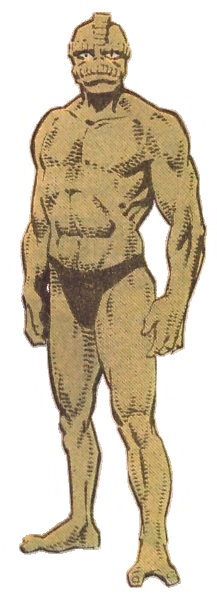
GEGKU race
Classification: Extratemporal (Earth-829) extraterrestrial semi-reptilian humanoids
Location/Base of Operations: Wilamean, third (or fifth) planet from the sun in the Gabansaa (or Yalnot) star system of the Andromeda Galaxy (see comments)
Habitat: 50% desert, 20% mountains, 30% water
Gravity: 90% Earth's
Atmosphere: 110% Earth density, similar composition to Earth's
Known Members:
Count Igwanus,
freedom fighters (none named)
Estimated population: 35 million
Affiliations: Wilameanis
Enemies: Galactus
(formerly):
Emperor Arimathes,
Emperor Mother Layana
First Appearance: Hercules I#2 (October, 1982)
Powers/Abilities: None known
Type: Semi-reptilian humanoid
Eyes: Two
Fingers: Three (plus opposable thumb)
Toes: Two
Skin color: Dark green, scaled (may become light green with age)
Hair: None
Average height: 6' 6"
Special adaptations: Although possessing reptilian characteristics such as scales, the Gegku are (allegedly) actually mammalian, and (supposedly) capable of mating with the more clearly humanoid Wilameanis, with whom they share the planet. The Gegku may (or may NOT) be a mutated (or Deviant) offshoot of the Wilameanis race. (see comments)
Type of government: Feudal. Although the Wilameanis dominate the planet, the Gegku possess great power and influence
Level of technology: Comparable to that of Earth
Cultural traits: Male chauvinistic, with a strong sense of honor towards fellow humanoid males
History:
(Hercules I#2 (fb) - BTS) - The Gegku are a race of "lizard-men" who live on the planet Wilamean which is located somewhere in the Andromeda Galaxy.
(Official Handbook of the Marvel Universe I#3: Alien Races: Gegku sub-profile/Official Handbook of the Marvel Universe II#15: Alien Races: Gegku and Wilameanis sub-profiles) - The Gegku share the planet Wilamean with the Wilameanis, a more clearly humanoid race. Despite the fact that the 4.8 billion Wilameanis vastly outnumber the 35 million Gegku and dominate the planet, the Gegku possess great power and influence.
(Hercules, Prince of Power: Full Circle Graphic Novel (fb) - BTS) - The Gegku had their own "nation" on Wilamean.
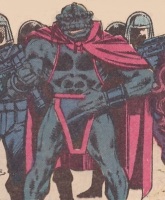
(Hercules I#2 (fb) - BTS) - Sometime in the middle third of the 24th Century (Earth chronology), a wealthy and noble-born male Gegku named Count Igwanus met a young Wilameanis woman named Layana Sweetwater who was the daughter of a very important member of the administrative council of Port Anteris, the planet's capital city. The two of them fell in love and became engaged to be married. However, while Layana was on her way to their wedding, the transport ship bound for the outer planets on which she was travelling was hijacked by pirates who kidnapped her. The Port Anteris Police Department made four attempts to rescue her from the pirates' island fortress but when they all failed the police offered a 10,000 credit reward for her rescue and safe return.
(Hercules I#2) - The Olympian demigod Hercules happened to arrive on Wilamean and he and Recorder #417 soon rescued Layana from her kidnappers. However, after discovering that the police didn't actually have the credits to pay the reward, Hercules decided that Layana would remain his charge until he was paid, and Layana, who had decided that she liked Hercules more than Igwanus, was happy to stay with him. Hercules and Layana then went to his quarters where they proceeded to engage in some "romance." Later, when Hercules mentioned that he would have to return her to her father, Layana lied and told him that her evil father had sold her to the wealthy and ruthless Count Igwanus for a small fortune and that she had been running away when the pirates had kidnapped her. Hercules reassured her that she was safe at his side where she would remain. Seconds later, Hercules opened the door and found himself facing members of the Port Anteris police and Count Igwanus who announced that he had come to claim his betrothed and asked if Hercules would do the honorable thing and surrender her to him. When Hercules refused, Igwanus told him to surrender Layana or they would take her by force, and Herc responded by knocking them all off their feet so that he and Layana could escape. After a short-lived escape attempt led to a showdown with Igwanus, Hercules demanded that the count renounce his purchase of the girl, only to be shocked when the puzzled Igwanus revealed that Layana had betrothed herself to him of her own free will. When Hercules asked Layana if Igwanus spoke the truth, the girl admitted that she and "Iggy" had been sweethearts who had decided to be married but that after she had met Hercules she realized that she wanted him more and so had made up the story about her daddy selling her so that Hercules would keep her. Hercules then apologized to Igwanus, stating that he had been misinformed about his nature and told him that the girl was his if he still wanted her. Igwanus accepted, saying that he supposed it seemed strange to Hercules but "strange are the ways of love." Igwanus then paid Hercules the 10,000 credits that he had earned by rescuing Layana.
Note: It has never been revealed if Count Igwanus and Layana Sweetwater ever actually did get married. At some point, Layana discovered that the way in which she had rewarded Hercules for rescuing her had left her pregnant with his child. It has also not been revealed how Igwanus reacted to this news.
(Hercules, Prince of Power: Full Circle Graphic Novel (fb) - BTS) - Angry that Hercules had rejected her, Layana transformed from a petty and fickle child to a bitter and vengeful woman. Realizing that her son, who she named Arimathes, might possess all the same godly powers as his father, Layana began to instill in him an intense hatred for Hercules. From a young age, she repeatedly told him lies about his father, and nurtured his hatred until he became obsessed with making Hercules pay dearly for his "transgressions" against Layana. One of the lies that she told Arimathes was that Hercules had known that she was pregnant but that he had "sold her to the Gegku" (presumably Igwanus) because he didn't want to "be burdened by a woman and bastard child" since that would have interfered with his swilling and woman-chasing across the universe.
(Hercules, Prince of Power: Full Circle Graphic Novel (fb) - BTS) - Once Arimathes had grown to maturity, Layana guided him into using his god-born might to subjugate the entire star-system, beginning with Wilamean and then conquering the outer planets. With her son in control as the emperor, Layana used her new position as the Emperor-Mother to take her revenge upon Count Igwanus. When she was done with him, a crippled and blinded Igwanus was forced to serve as a slave in the imperial palace. His duties included providing weekly injections of the nutrient Gruel-X to the people being kept in a "living death" state of lying paralyzed from the neck down on beds in the underground Stasis Chamber.
Layana's revenge on Igwanus included having her son oppress the Gegku race, killing many but allowing some of "Igwanus' kind" to live. Apparently, the rank or station of each Gegku had some bearing on whether they lived or died.
(Hercules, Prince of Power: Full Circle Graphic Novel) <2385 A.D. (Earth date)> - Thirty (Wilamean) years after his first visit, Hercules returned to Wilamean where, after being stunned by guards at the command of Emperor Arimathes and imprisoned in the Stasis Chamber, he was soon confronted by the Emperor-Mother who revealed her identity, the existence of their son, and how she had manipulated Arimathes in order to gain power for herself and to engineer the destruction of Hercules.
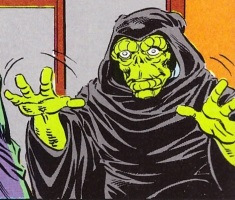
(Hercules, Prince of Power: Full Circle Graphic Novel) - "Weeks" later, as the preparations for the planned attack on the Omacron system were nearly complete, Emperor Arimathes and the Emperor-Mother were reviewing the assembled might of his imperial warriors when a group of Gegku freedom fighters suddenly attacked, proclaiming "Death to the tyrant! Death to the oppressor of the Gegku race!" Unfortunately for the would-be assassins, one of the emperor's loyal minions was struck by their deadly rays as he warned his liege. As the Emperor-Mother ordered the troops to fire on her signal, Arimathes countermanded those orders, telling the warriors to not interfere so that everyone could witness his power and tremble. Arimathes then quickly battered some of the assassins to death, then threw a shuttle on top of the rest of the rebels as they attempted to flee, telling them that they "may join the rest of (their) miserable sub-species -- in DEATH!" With all of the assassins now dead, Arimathes stated that he now saw that it had been "a mistake to allow any of Igwanus' kind to live" and he then ordered Sub-Commander Tsak to have "all Gegku regardless of rank or station rounded up for disposal at the earliest possible convenience!" With a shaky voice, Tsak acknowledged the order.
Meanwhile, Igwanus had been making his rounds in the Stasis Chamber and recognized Hercules by his voice when the demigod commanded him to keep his foul potions to himself. Once Igwanus had revealed how he had ended up a broken and blinded palace slave, Hercules convinced the once-leader of the Gegku nation to free him and a few companions. Hercules, Igwanus, Skyppi, the Recorder and two others then escaped by secretly taking control of one of the ships in the armada. After using Skyppi's shape-shifting ability to temporarily halt the fleet, Hercules publicly called Arimathes a coward and challenged him to a test of combat. After the enraged emperor had accepted, Hercules and company flew their stolen ship to the large planetoid that Arimathes had chosen for the battle. Once there, a somber Hercules received some wise counsel from Igwanus who pointed out that the emperor had to be humbled if he were to be turned from his destructive ways and that Hercules should exploit his son's obvious weakness (his arrogance) to make him see his true self and let him defeat himself. Following the Gegku's advice, Hercules blindfolded himself before the battle and managed to defeat Arimathes because the emperor's constant bellowing enabled the demigod to always know where to strike even without his sight. Impressed by the fact that Hercules had risked his life in order to show his son the truth of things, Arimathes asked his father to teach him what he was lacking.
(Hercules, Prince of Power: Full Circle Graphic Novel (fb) - BTS) - As part of his new way of ruling, Emperor Arimathes had all of the political prisoners released from the Stasis Chamber and he appointed Igwanus to serve as his private council. It wasn't made clear if the order to kill all of the Gegku was cancelled in time.
(Hercules, Prince of Power: Full Circle Graphic Novel) - As Hercules and his friends walked through the palace, the Olympian rejoiced in the fact that he was the father to the finest ruler that gleaming galaxy would ever see...just as Igwanus began to fall after being tripped by Skyppi.
And no Gegku has ever been seen since in any Marvel story.
Comments: The Gegku race was created and named by Bob Layton and Luke McDonnell.
Thanks to Snood for getting me a scan of the first image of the Gegku freedom fighters. I couldn't have used my scanner to get that image unless I had torn the GN apart at the spine.
Members of the Gegku race have only ever appeared in
Marvel stories set in the 24th Century of the alternate timeline known as Reality-829.
However, according to The Official Handbook of the Marvel Universe II#15,
Captain Cybor from Incredible
Hulk II#137 is a member of the Wilameanis race that exists in Reality-616. This may indicate
that Gegku live in Reality-616 as well.
I don't like this because I really hate the idea that the pink-skinned humanoids seen living on Wilamean are
yet another example of just how many races who are identical-to-Caucasian-humans exist in
the Marvel Universe. I'd much prefer it if some of these apparently-identical races could
be revealed to actually be long-separated groups descended from a single race.
Where in the Andromeda Galaxy is Wilamean?
According to the quarter-page profiles on the Gegku race
in the original and deluxe editions of The Official Handbook of the Marvel Universe, their
race is from Wilamean, the third planet out from the sun in the Gabansaa star system.
However, the quarter-page profile on the Wilameanis race in the deluxe edition of the
Official Handbook states that their race is from Wilamean, the fifth planet out from the
sun in the Yalnot star system. Obviously this is a problem since a single planet cannot
orbit suns in two different star systems nor can it orbit a single sun at two different
distances. This should be fixed.
It should also be noted that two stories make mention of either "outer planets" that are inhabited and/or planets at the border of "the planetary system known as Wilamean." Some explanation/clarification would be appreciated.
Chronological contradiction?
1. In the first Hercules limited series, Recorder #417's adventures with
Hercules took place over the course of "many months." During that time, they encountered
Layana Sweetwater on the planet Wilamean (in issue #2) before they met Commander Amayd Malin
in the Omacron system (in issue #3).
2. The first issue of the second Hercules limited series specifically stated that "By Earth
chronology, it (was) the year 2385." In that same issue, the dying Commander Malin and
Hercules both recall that it had been "forty-one years" since they met.
3. In the Hercules, Prince of Power: Full Circle graphic novel, which takes place soon after
the end of the second limited series, there are multiple references to the fact that Hercules
had visited the planet Wilamean "thirty years ago."
While at first glance this does seem to be a problem, I believe that an easy solution is to be found in the fact that these two encounters took place on planets in two different star systems. A year is the time that it takes any given planet to make one complete orbit around its star and it follows that (almost) every planet in the universe must therefore have a year whose length is uniquely different from that of the years of all other planets. For example, within our own solar system, a Martian year is 687 (Earth) days long while the years on other planets range from 88 (Earth) days for Mercury to 248 (Earth) years for Pluto. With that in mind, it seems perfectly plausible that 41 years as measured in the Omacron system could be equal to only 30 years on the planet Wilamean. All that would be required is that one year on Wilamean be about 37% longer than one Omacron year. Of course, this also means that neither an Omacron year nor a Wilamean year are likely to be the same length as Earth year, so that would make it still difficult/impossible to pinpoint exactly when Hercules was banished by Zeus and when he first visited Wilamean. Without knowing the relative lengths of the various years involved, "around 2344 A.D." is only a best guess.
Genetically compatible...or not?
1. The quarter-page profile on the Gegku race in The Official Handbook of the
Marvel Universe I#3 states that "the Gegku are actually mammalian, and capable of mating with
the more clearly humanoid Wilameanis, with whom they share the planet." It also suggests that
the Gegku may be a "mutated offshoot of the Wilameanis race."
2. The quarter-page profile on the Gegku race in The Official Handbook of the Marvel Universe
II#15 repeats the idea that the Gegku are mammalian and capable of mating with the Wilameanis
but suggests that the Gegku "may be the Deviant offshoot of the Wilameanis race." However,
the profile on the Wilameanis does not mention them being capable of mating with the Gegku.
In fact, the Wilameanis profile doesn't mention the Gegku at all.
3. In the Hercules, Prince of Power: Full Circle graphic novel, Emperor Arimathes kills the
Gegku rebels who tried to assassinate him, saying that they can join the rest of their
"miserable sub-species" in death! However, it's unclear if Arimathes was using the term
"sub-species" correctly (as in, the Gegku and the Wilameanis are two related sub-species) or
in a derogatory manner (as in, the Gegku are an inferior [sub-human] species).
First, these claims by the Handbooks that the Gegku are mammalian and capable of mating with the Wilameanis are based entirely on the idea that Count Igwanus and Layana Sweetwater not only fell in love and became engaged but also planned to have children together. However, the story in Hercules I#2 contains ABSOLUTELY NO MENTION of them wanting to start a family together. So, since people in the real world can fall in love and marry even if they can't (or don't want to) have children together, that makes the idea that the Gegku and the Wilameanis can inter-breed more of an assumption on the part of the Handbook writers than a "fact."
Second, although Hercules I#2 makes it clear that the Gegku and the humanoids (who, by the way, have never been identified as "Wilameanis" in any story) both live on a planet known as Wilamean, there is no hint of any connection beyond their co-habitation of that planet. So, without any evidence to point the way, we are free to speculate as to what exactly is the relationship between the two races. Here's my list of ten possible explanations.
Personally, I like any theory which reduces the number of
"identical-to-Caucasian-humans" races who evolved independently on different planets and
making the "Wilameanis" just a colony-world offshoot of one of the (too) many pre-existing
humanoid races in the MU serves that purpose. As to the origin of the Gegku, the idea that
they were the dominant native race until the humanoids arrived and began to take over is a
familiar story. In the real world, many "primitive" human cultures have been marginalized by
"more advanced" Europeans who came to their lands, established colonies and overwhelmed the
natives with their technology and numbers. In the Marvel Universe, a similar story took place
in Reality-691 when, in the mid-30th Century, Terrans explorers from Earth founded a colony
on the planet Centauri-IV in the Alpha Centauri star system and soon took control of the
planet from the less technologically advanced native Centaurian race. So, I prefer theory
#8 but the Official Handbooks seem to really like either of the first two theories. Any
opinions?
No opinions, just the facts. The handbooks identified the Gegku as a
sub-species of the Wilameanis and later clarified that this sub-species
was a Deviant race. We have in-story evidence of the Gegku being
referred to as a sub-species. There is no reason to argue against this,
other than your dislike of the abundance of "identical-to-Caucasian-humans" races.
--Snood.
Profile by Donald Campbell.
CLARIFICATIONS:
The Gegku race has no known connections to
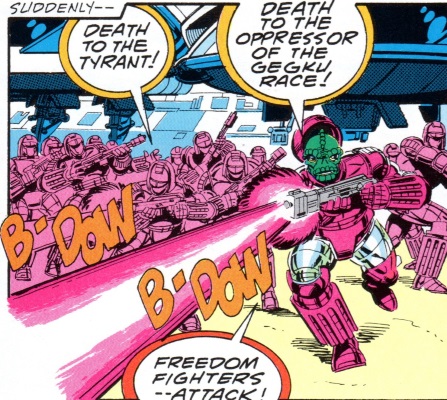
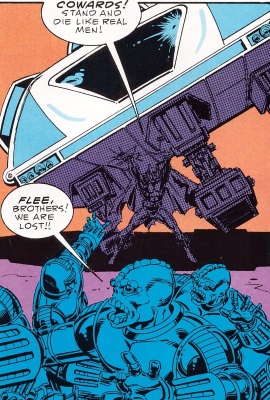
A group of male Gegku who felt compelled to rebel against Emperor Arimathes because of how he had oppressed the Gegku race during his reign. Although no details about this oppression have been revealed, it seems certain that these rebels had all lost friends and/or family members due to Arimathes' tyrannical rule. None of their names were ever revealed and neither was the size of their group.
In the Earth year 2385 A.D., the rebel Gegku resolved to assassinate the emperor. As preparations for the upcoming invasion of the Omacron system neared completion, the rebels decided that their best opportunity would be to strike while the emperor was personally conducting a final review of his invasion fleet and the loyal imperial troops. Accordingly, the rebels acquired some imperial uniforms and infiltrated the palace disguised as troopers.
As Emperor Arimathes, accompanied by the Emperor-Mother and an aide, reviewed his assembled minions, the disguised rebels waited until he passed close to them before they struck. One of the rebels shouted, "DEATH TO THE TYRANT!" as he opened fire while another, whose helmet fell off as he charged forward, proclaimed, "DEATH TO THE OPPRESSOR OF THE GEGKU RACE!" as he also opened fire, calling out to the "freedom fighters" to attack. Unfortunately for the rebels, the aide was struck by the energy blasts as he tried to warn his liege, and his body (perhaps inadvertently) shielded Arimathes from harm. Despite having lost the element of surprise, the rebels continued firing but Arimathes was able to evade their blasts (possibly because they were lousy shots). The Emperor-Mother ordered the troops to fire on her signal but Arimathes told his warriors to not interfere because the rebels were his and he wanted to let everyone witness his power and tremble. Stating that "these cowardly assassins (were) no match for (his) princely might!" and saying that he would allow them to take his life if they could, the emperor leaped into a group of six of the assassins and began fiercely pummeling them with blows that knocking them flying or shattered their helmets. With the enraged emperor raving as he stood amidst the bodies of at least half of their number, the remaining rebels attempted to escape but Arimathes denounced them as "COWARDS!" and demanded that they "Stand and die like real men!" Arimathes then single-handedly lifted up one of the shuttles and hurled it atop the fleeing rebels, crushing them all as he decreed that they could "join the rest of (their) miserable sub-species -- in DEATH!"
Once the rebels were dead, all those present remained nervously silent until Arimathes spoke again, stating that he now saw that it had been "a mistake to allow any of Igwanus' kind to live" and he then ordered Sub-Commander Tsak to have "all Gegku regardless of rank or station rounded up for disposal at the earliest possible convenience!" With a shaky voice, Tsak acknowledged the order.
In all, between six and twelve Gegku died during this ill-fated assassination attempt. Tragically, it was only hours later that Emperor Arimathes was confronted by his father, the demigod Hercules, who forced his son to see the error of his ways and free his tortured soul from the hatred that had been placed within it by his despicable mother. So, basically, all of these freedom fighters died for nothing.
--Hercules, Prince of Power: Full Circle Graphic Novel
images: (without ads)
The Official Handbook of the Marvel Universe II#15, page 42, panel 2 (main image)
Hercules I#2, page 17, panel 4 (Count Igwanus in his prime)
Hercules, Prince of Power: Full Circle Graphic Novel, story page 47, panel 4 (Igwanus
after torture)
story page 39, panel 2 (rebellion...)
story page 40, panel 2 (...about to be crushed)
Appearances:
Hercules I#2 (October, 1982) - Bob Layton (story, layouts & finished art), Luke McDonnell
(art assist), Mark Gruenwald (editor)
Marvel Graphic Novel: Hercules, Prince of Power: Full Circle (1988) - Bob Layton (story and
art), Gregory Wright (editor)
First Posted: 08/30/2017
Last updated: 08/30/2017
Any Additions/Corrections? please let me know.
Non-Marvel Copyright info
All other characters
mentioned or pictured are ™ and © 1941-2099 Marvel Characters, Inc. All
Rights Reserved. If you like this stuff, you should check out the real thing!
Please visit The Marvel Official Site at: http://www.marvel.com
Special Thanks to http://www.g-mart.com/ for hosting the Appendix, Master List, etc.!